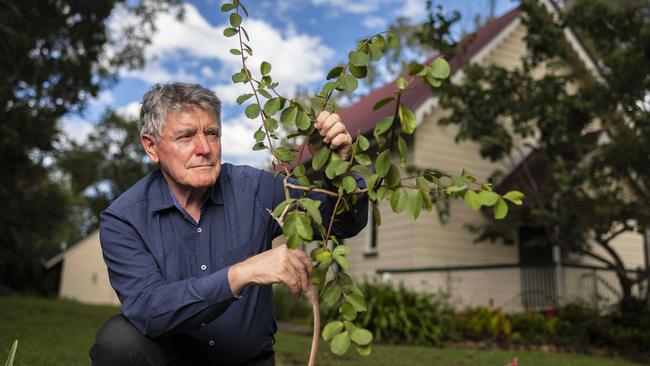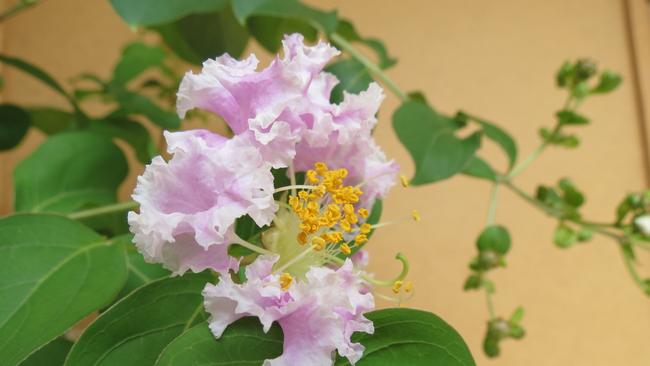Tree that helped catch Allison Baden-Clay’s killer husband a living tribute to her
It was a ‘witness’ to Allison Baden-Clay’s murder – now this unassuming crepe myrtle will stand in tribute to her.

If a plant can bear witness to murder, an unassuming crepe myrtle has. And it will now stand in tribute to Allison Baden-Clay at a church in Brookfield, Brisbane, to mark the 10th anniversary of her killing.
For the past decade, Queensland Herbarium director Gordon Guymer has looked after the plant, which he originally took as a cutting from Baden-Clay’s yard when he was helping police investigate the crime.
It was used for DNA comparison to leaves found tangled in her hair and on her body – leaves that would ultimately be pivotal in proving she had died at her home.
This month, he will plant it on the grounds of the small church next to Baden-Clay’s former home as a living memory of her.
“It should be a good remembrance of her, for people to be able to reflect on her life and her achievements,” Dr Guymer said.
Baden-Clay was reported missing from the home by her husband, real estate agent Gerard Baden-Clay, on the morning of Friday, April 20, 2012.

Ten days later, her body was found beneath the Kholo Creek bridge, 14km away.
Queensland’s leading botanist was called in by police on the off chance plants could further the investigation. And his evidence became a key pillar in the case against Gerard Baden-Clay for his wife’s murder, along with the fingernail gouges on his face and a trail of Allison Baden-Clay’s blood in her Holden Captiva.
In the botanical material recovered from her hair and body, Dr Guymer identified remnants of six plant species: crepe myrtle, Chinese elm and lilly pilly leaves; a tendril and leaflets of cat’s claw creeper; fronds of fishbone fern; and bark and leaves of eucalyptus.
Only Chinese elm and eucalypts grew near the muddy creek bank where her body was found, but in the yard at her home Dr Guymer distinguished the same array of plants he had found in his lab.
Bare crepe myrtle trees had deposited a thick layer of leaves on the back patio, mingling with fallen fronds of fishbone ferns.
A Chinese elm stood nearby. Cat’s claw creepers were wrapped around the crepe myrtles.
Nowhere else the botanist looked between the property and Kholo Creek bridge could he find the same combination of plants.
Hours before she vanished, Allison Baden-Clay had been to her local hairdresser.
It appeared her body was dragged through leaf litter on the back patio, leaves catching in her freshly washed and coloured hair.
Dr Guymer remembers some police were at first sceptical plants could be of much value. That soon changed as the importance of his findings dawned on investigators.

Through Dr Guymer, police then tried to find a DNA match between the leaves from Baden-Clay’s hair and body to the plants in her yard.
Dr Guymer used cuttings from the bare crepe myrtles to grow leaves for comparison, sending them to the University of Adelaide, which ultimately found the leaves from the hair and body were unsuitable for DNA analysis – they could have been months old and had degraded over time.
“But it was good to see police were willing to look at new ideas, approaches and technologies. They were exploring every opportunity,” Dr Guymer said.
Gerard Baden-Clay was convicted of his wife’s murder and is now two-thirds of the way through his minimum 15-year sentence.
Since Dr Guymer’s work on Allison Baden-Clay’s case, police have asked him to examine plant material from other homicides.
These include the killings of Gatton schoolgirl Jayde Kendall and Redcliffe woman Tricia Riggs.
“Forensic botany is coming on in leaps and bounds,” Dr Guymer said. “Now that we’ve got DNA fingerprinting for plants, I think that’ll certainly become a standard technique into the future.”
In the days after Allison Baden-Clay’s murder, heavy rain washed away traces of her killer as her body lay on the creek bank, but the leaves from her garden stayed with her, yielding important evidence thanks to Dr Guymer’s investigations.
The crepe myrtle from her yard will be planted in the Anglican Church of the Good Shepherd’s “garden of memories” for those who have died.
When it blooms – typically for crepe myrtles, this occurs in heavy rain – the pretty lilac flowers will be a reminder of the devoted mother-of-three, who would have been be 53 if alive today.




To join the conversation, please log in. Don't have an account? Register
Join the conversation, you are commenting as Logout